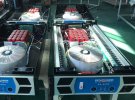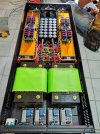I've handled thousands of SMPS toroidal transformers in high end car amps when I used to repair them in the late 80s and through the 90s. I'm familiar with the high current type of SMPS and they are certainly different than anything I've seen in a home audio application. Big difference.If you check Yorkville sounds ratings for toroidal amps, you will note they were one of the few manufacturer, to also add the burst ratings. Almost any toroidal amplifier, using the same measuring tactics, currently used to measure smps power, would easily double their current and actual specifications, and this is after the fact, that many of these high powered pro amplifiers used under rated transformers to begin with.
I'm not used to adding up expenses for home audio circuitry but now that you mention this I suppose you have a valid point.For one simply add up the costs. SMPS is comprised of nothing but transistors, diodes, smaller value capacitors etc.
True that.When SMPS was invented, they changed the way power amplifiers were rated. Power was now rated as a 22ms burst, despite the fact 500ms burst would be required to mimic a complete audio signal, and 3 seconds full burst would be required for EDM bass. Today most SMPS are measured this way, and you can find WIlliston Audio labs using the AMP DYNO, to measure thousands of amplifiers, this exact same way. AS such I have always said we are using measuring specifications of power , that do not even reproduce an audio signal.
I figured a solid 500W/ch would require a a more capable transformer.


